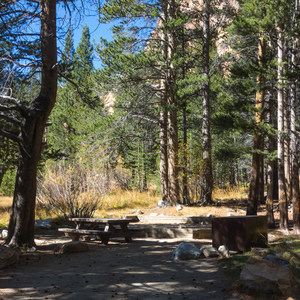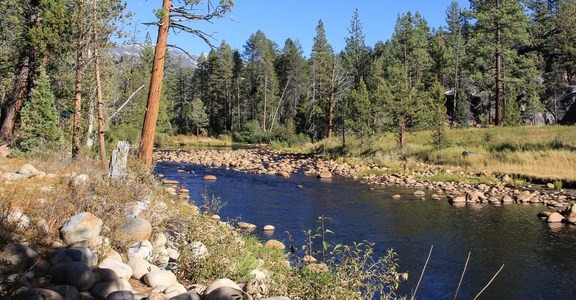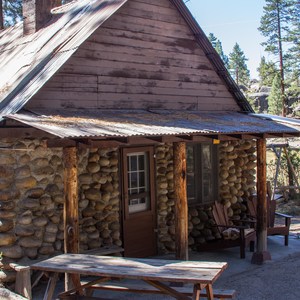Regarded by many as the premier hiking trail in the country, the John Muir Trail (JMT) runs along the backbone of California’s High Sierra between Yosemite National Park and the summit of Mount Whitney. The 211-mile long trail commemorates the influential naturalist and founder of the Sierra Club, John Muir, who’s understanding of the landscape and voice for conservation laid the groundwork for protecting much of the Sierra through the establishment of Yosemite, Kings Canyon and Sequoia national parks. The JMT can be done in segments or as a thru-hike, many opting for the latter. Pre-planning is critical to a successful JMT thru-hike; advance permits are required. Most hikers take around three weeks to complete the journey following the trail southbound (SOBO) from Yosemite Valley. See the John Muir Trail Overview for more information on logistics and permit information.
This section covers the JMT from the Piute Pass Trail junction to the Woods Creek Trail, located 50 miles to the south. One of the most dramatic and remote segments of the JMT, this section climbs into the higher country of Kings Canyon National Park and crosses three 12,000-foot mountain passes. JMT hikers will enjoy this section for its scenic diversity, from the rugged and exposed landscape of Evolution Basin to the verdant meadows cradled in LeConte Canyon and Evolution Valley. The trail also sticks close to and crosses some beautiful stretches of flowing water including the South Fork of the San Joaquin River, Palisade Creek, and the headwaters of the South Fork Kings River. Expect to get your boots wet and pay attention to river flows. Two backcountry ranger stations are located along the JMT here, but note that there are no near-trail resupply points beyond Muir Trail Ranch for the remainder of the trail.
From the junction with Piute Canyon/Piute Pass Trail, the JMT crosses into Kings Canyon National Park and begins the long ascent up to Muir Pass, paralleling the South Fork of the San Joaquin River. Leaving the river behind, the trail climbs toward the cradled confines of Evolution Valley. The trail follows Evolution Creek through the valley floor, passing through Evolution Meadow, McClure Meadow (there is a backcountry ranger station located here), and Colby Meadow along the way.
Near the head of Evolution Valley the trail climbs another steep bench to reach Evolution Lake, one of the most picturesque lakes on the trail, nestled below the peaks of Mount Darwin, Mount Mendel, and other summits of the Evolution Range. There are nice camps in this area, although Evolution Lake sees a lot of use. Please take care to follow Leave No Trace principles and park guidelines for camping.
Beyond Evolution Lake the trail climbs through the rugged landscape of Evolution Basin toward Muir Pass. At 11,955 feet, Muir Pass is the high point of the JMT thus far for SOBO hikers, affording excellent views of the Goddard Divide, Mount McGee, and Black Giant. Muir Pass is also home to Muir Hut, an iconic landmark of the JMT constructed by the Sierra Club in 1930 to provide temporary shelter to hikers caught in inclement weather along this exposed portion of trail (overnight camping and fires prohibited). Afternoon thunderstorms are regular occurrences in the High Sierra during summer, and this is a section without much cover. During peak months, JMT hikers may encounter other backcountry trekkers admiring the hut or warming up, as it’s often a gathering point along the trail.
The trail continues south and descends past alpine lakes into picturesque LeConte Canyon. LeConte Canyon is filled with serene meadows fed by the upper waters of the Middle Fork of the Kings River and Palisade Creek. Big Pete, Little Pete, and Grouse Meadows all offer beautiful surroundings for some relaxation. LeConte Canyon is also the location of the second backcountry ranger station along this section of the JMT, located at the junction with the Bishop Pass Trail. The meadows here are filled with pleasant campsites, although mosquitos can be thick in the early season. The JMT continues along the canyon, breaks off from the Middle Fork of the Kings River, and follows Palisade Creek up the Golden Staircase to Palisade Lakes above. Climbing the Golden Staircase in afternoon light affords spectacular views down the canyon, illuminated with golden hues. From Palisade Lakes it’s another push up and over 12,080-foot Mather Pass.
The distance Between Mather Pass and Pinchot Pass is less than 10 miles. The trail drops back down in elevation to cross the South Fork of the Kings River and the junction with the Taboose Pass Trail before climbing back up to Pinchot Pass. After Mather Pass the best camp is at Lake Marjorie, which sets JMT hikers up for an easy climb over 12,100-foot Pinchot Pass the following day. Beyond Pinchot Pass the JMT descends to Woods Creek. Another camp with bear boxes awaits hikers at the Woods Creek Trail junction, although this can get crowded with hikers circumnavigating the 42-mile Rae Lakes Loop.
For additional trail details, refer to the following John Muir Trail sections:











Comments
Sign In and share them.